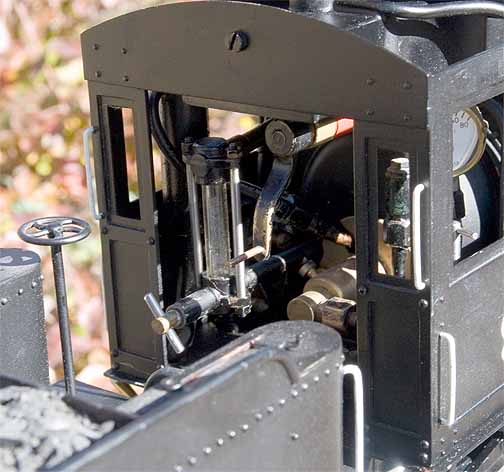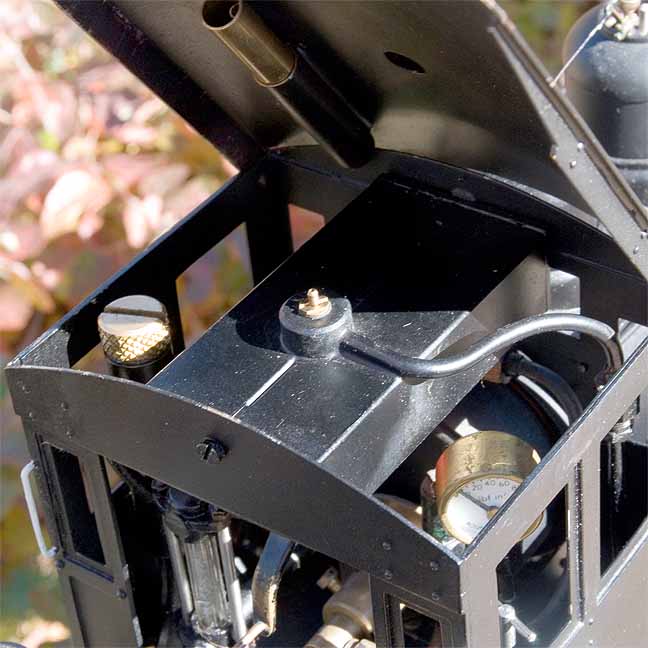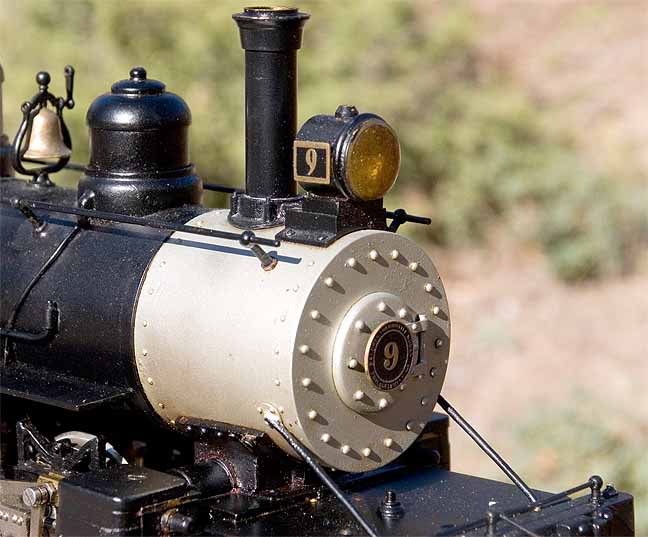
Back to Loco of the Month homepage
Back to Sidestreet Bannerworks
.
November 2008
Don Mason's 2-6-2
by Marc Horovitz

Ah, the joys of the Internet. When this was first posted, around November 1, 2008, I mentioned that I knew little of the builder. My small attempts to locate him had come to nought, as none I approached knew his whereabouts. So I posted what I did know about the engine. It wasn't three days later that I received an e-mail from the man himself! He told me that in mid 1996 he dropped out of 16mm-scale modeling to return to Maine narrow-gauge modeling indoors in a smaller scale. He also provided me with further information about the locomotive, which I have incorporated into the text below. Many thanks to Don Mason.
This is a freelance model, though it was inspired by the No. 6 Prairie of the Wiscassett, Waterville & Farmington Railway, which ran in Maine.This engine was purchased second-hand from him by my friend Dick Schafer in the middle 1990s. It was originally built to 32mm gauge for Don's Beaver Creek & Stony River Railroad. Dick regauged it to 45mm to run on his Galena Railway & Navigation Co., for which it is lettered.
The chassis is Roundhouse (essentialy as used on their SR&RL No. 24), but was assembled from raw, unmachined parts supplied to Don by Roger Loxley of Roundhouse Engineering, rather than being bought assembled and finished. The engine makes use of Roundhouse detail parts. Much of the engine is scratchbuilt. The cab is made of sheet metal. The roof hinges up at the leading edge. On the underside of the roof is a pocket that carries the handle for the tender pump. Immediately under the roof is the gas tank. The roof hatch opens to reveal the gas filler valve.
Backhead fittings include the throttle, a pressure gauge, a water glass with a blowdown valve, and a check valve. The safety valve, set at around 45 pounds, is under the steam dome, which lifts off for access. The boiler is copper and brass, built to Don's specification by a professional small-steam-boiler maker and has a simple center flue with cross tubes, and with a stainless-steel superheater pipe running through it. The boiler is completely lagged 1/8"-thick cork sheet which (a) helps prevent heat loss and (b) makes it possible to soft solder the fittings (domes, etc) to it. The gas valve is in the cab, disguised as a brake stand near the right-hand cab window. A displacement lubricator sits on the left side of the cab. It has a convenient drain valve, accessed below the cab.
The smokebox is copper, silver soldered from a piece of old pipe over the bird-table in Don's garden. The front handrail knobs are not actually attached to the smokebox, but are left loose, "supported" by the handrails, as he was worried about heat conducting back along the handrails to the boiler jacket, where everything is soft soldered in.
Valve gear is Roundhouse's dummy Walschaerts -- actually simple eccentric with a reversing link. Center drivers are blind for negotiating tighter-radius curves. The engine has outside frames. Overall, it is well made, highly detailed, and really looks the part.
The tender is scratchbuilt from brass. All of the rivets were put in individually. It hs a nicely made dummy coal load and a functional water tank. There's a hand pump under a dummy, lift-off tool box behind the coal load. A water line leads forward to the engine, where there is a screw connection. With the pump, and provided the gas is kept topped up, the engine can be kept in steam all day if required.
If you'd like to learn more about the originas and construction of this interesting locomotive, click here to read a fascinating letter that Don wrote concerning it.
The run
The run was done on a spectacular fall day, still, crystal clear, with the temperature in the low 70s and the neighbor's aspen tree bright yellow against an intensely blue sky. I prepared the engine in the usual way and lit it up. The fire didn't want to catch, but finally did, with little enthusiasm. It didn't sound right and there didn't seem to be much adjustment room. However, I let it go to see what would happen.
Not much did. After about 10 minutes, the needle had scarcely lifted from the peg. I shut off the fire, then tried it again a couple times with identical results. This had all the earmarks of a partially clogged gas jet.
I again shut the engine down and pulled out the jet housing, which involved undoing a couple of connections. Once it was free, I unscrewed the jet and held it up to the sun. Even with my naked eye, where I should have seen a tiny, perfect circle I saw a crescent moon. Something was in there. With my air compressor I blew out the jet (from the outside, so as not to blow the blockage further in). I also blew out the housing, which released a small puff of something -- the culprit , no doubt.
I reassembled the jet in the engine and lit the fire once again. What a difference! The fire burned loud and strong. In a few minutes steam was up and I opened the throttle. After a few seconds of the usual sputtering and jerking, it moved smoothly away.
This engine is a pleasure to run. It is interestingly slow to respond to throttle commands. If you close the throttle, the engine will slowly come to a halt a couple of yards down the line. If the throttle is opened while the engine is standing, there will be a couple of seconds hesitation before it slowly and realistically starts and picks up speed.
The run last a half hour or so, when the fuel was exhausted. Once the initial trouble had been remedied, the locomotive performed as well as anyone could expect -- a perfect run on a perfect day.
|
|
|
| Builder | Don Mason (UK) |
| Date built | Circa 1992 |
| Gauge | 45 mm |
| Scale | 1:22.5 |
| Boiler | Single flue with cross tubes |
| Fittings | Safety valve, pressure gauge, water glass, throttle, blowdown (on water glass) |
| Fuel | Butane |
| Blow-off pressure | 45 psi |
| Cylinders | Two, double-acting D-valve |
| Reversing gear | Modified Walschaerts (simple eccentric) |
| Lubricator | Displacement |
| Weight | 11 pounds (loco and tender) |
| Dimensions | Length over end beams (loco and tender), 23-3/8"; width, 4"; height, 6" |






Above: For quick access to the gas tank's filler, the roof hatch can be opened.






Back to Loco of the Month home page
Back to Sidestreet Bannerworks home page
This page and its contents
Copyright Sidestreet Bannerworks, 2008
.